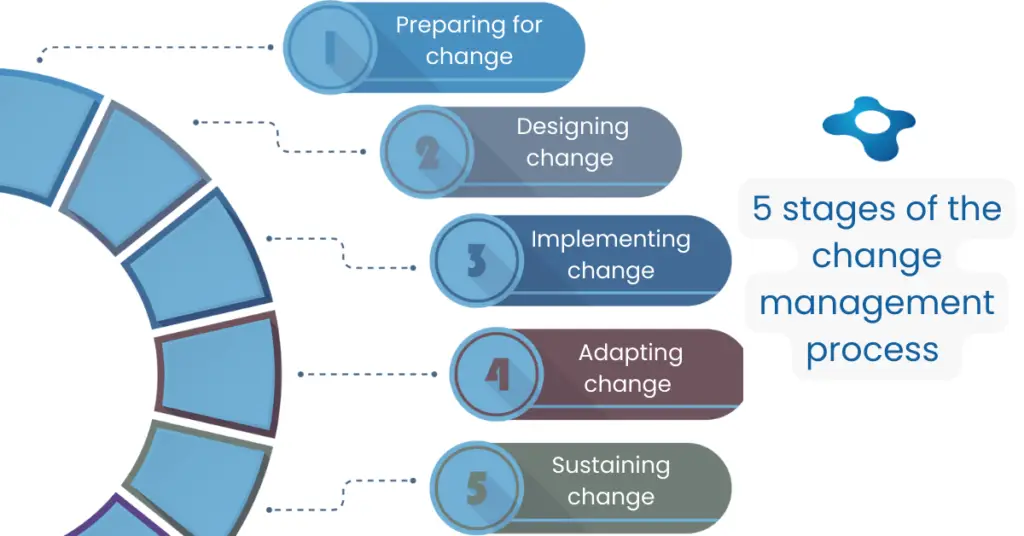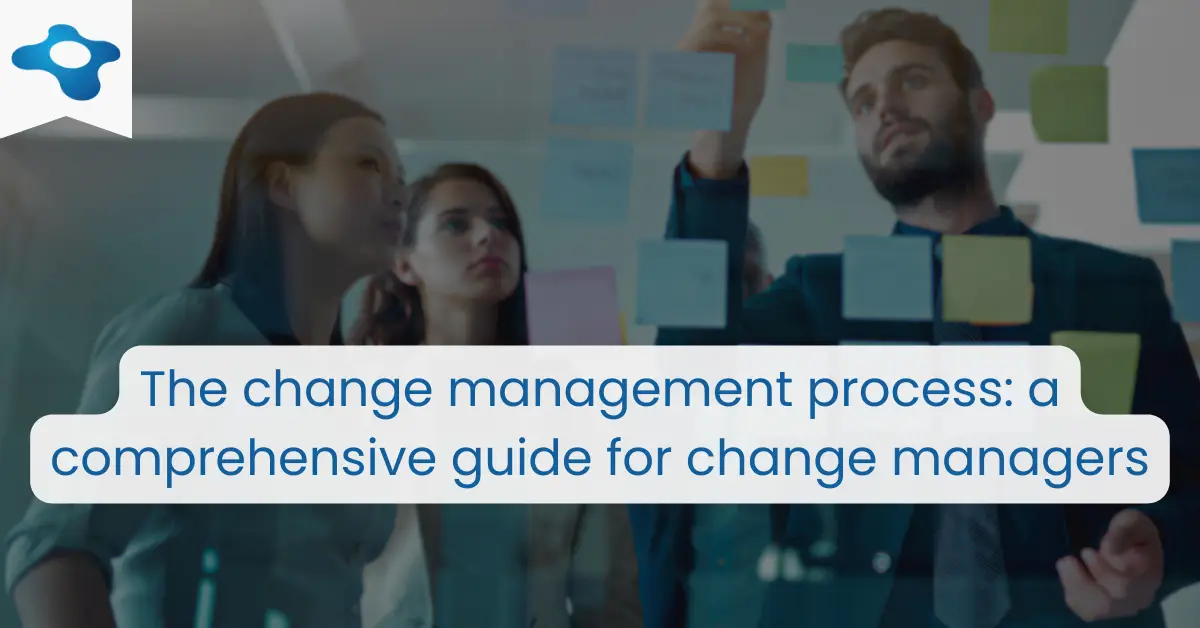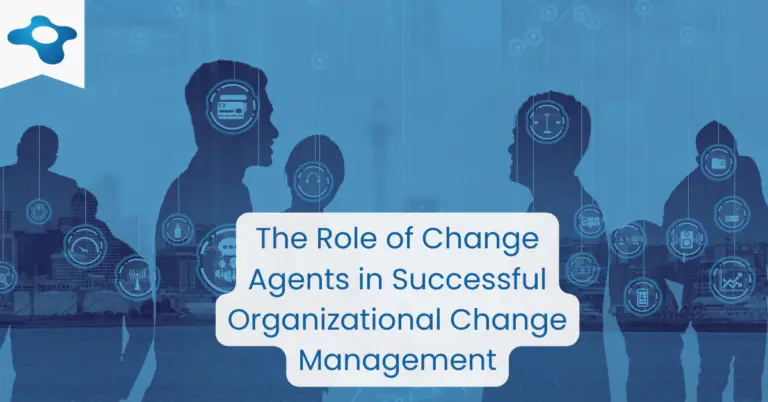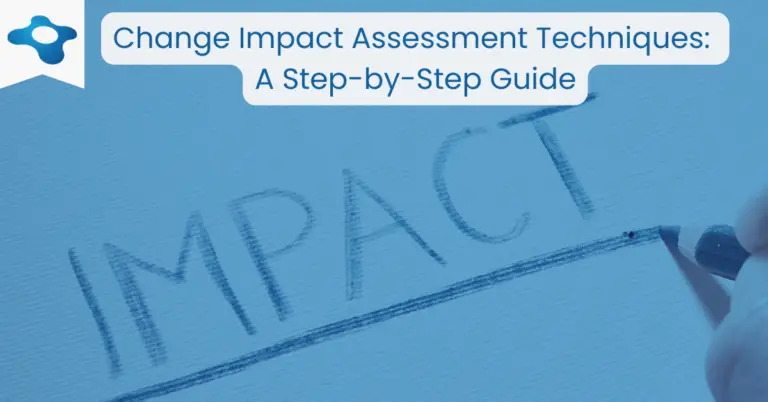Key Takeaways
- The change management process comprises five key phases: (1) preparing for change (2) designing the change (3) implementing the change (4) adapting the change and (5) sustaining the change.
- By following a structured change management approach, organizations can overcome resistance, support employees during transitions, and create a more resilient and adaptable organization for the future.
- Effective change management involves fostering a shared understanding of change objectives, promoting strong leadership, engaging stakeholders, and aligning organizational culture and structure with the desired future state.
Change is a fact of life that businesses must navigate to survive – let alone thrive – in today’s fast-paced world.
While many organizations recognize the importance of adapting to change, not all have the know-how to manage the process effectively. A structured approach to change management is essential for organizations looking to successfully implement transformation that drives growth and maintains competitiveness.
In this article, we’ll explore the change management process in-depth, taking you through its five critical phases, and their component parts. We’ll also discuss the six best practice areas for successful change management and how they contribute to driving successful outcomes.
Understanding the change management process
It’s important to understand that when we talk about an overall ‘change management process,’ we’re referring to a series of interconnected phases, processes and sub-processes, all of which need to be rooted in a firm understanding of change best practices.
Taking a structured approach to change management not only increases the likelihood of success but also ensures that the organization’s resources are efficiently utilized, and employees are effectively engaged throughout the change process.
This holistic approach ensures that change management is not only effective but also sustainable and adaptable to the evolving needs of the organization.
The 5 stages of the change management process
The change management process can be broken down into five key phases, with which you can guide organizations through the entire transformation journey.

Following these phases not only provide a clear roadmap but also ensure all aspects of the change are comprehensively addressed and your plans are fully ‘joined up’.
1. Preparing for Change
This initial phase involves setting the foundation for the upcoming change. It includes defining the future state of the organization as well as establishing change governance, which is the framework for overseeing and managing the change process effectively.
This phase helps to create a shared understanding of the need for change and the desired outcomes. Key processes include:
- Define Future State: Establish a clear vision of the organization’s future state, which will guide the change process.
- Define Change Governance: Create a governance structure to manage the change process effectively, ensuring alignment with organizational goals.

• A retail company plans to introduce a new e-commerce platform to expand its online presence.
• During the ‘preparing for change’ phase, they established a clear vision for their future state which included a clear picture of what ‘improved customer engagement’ would look like leading to increased online sales.
• Using this as the foundation they then set up a change governance structure, appointing a steering committee to oversee the project and ensure it aligns with the organization’s goals.
2. Planning and Designing Change
During this phase, organizations develop a comprehensive change strategy, assess the impact of the change, and create a change management plan.
This stage also involves developing and supporting change leaders and engaging stakeholders through a change agent network.
Key processes include:
- Develop Change Strategy: Formulate a well-defined strategy that outlines how the organization will achieve the desired future state.
- Change Impact Assessment: Evaluate the potential impact of the change on various aspects of the organization.
- Change Management Plan: Develop a detailed plan that outlines the approach, activities, and timeline for implementing the change.
- Develop Change Leaders: Identify and develop individuals who will play a crucial role in leading and managing the change.
- Support Change Leaders: Provide ongoing guidance and support to change leaders, ensuring they can effectively drive the change process.
- Stakeholder Analysis: Identify key stakeholders and their potential influence on the change process.
- Build Change Agent Network: Establish a network of individuals who can champion the change and support its implementation throughout the organization.

• A healthcare organization is implementing a new electronic health record (EHR) system to improve patient care.
• During the planning and designing change phase, they develop a change strategy that outlines the steps needed to achieve successful EHR adoption.
• The organization performs a change impact assessment, identifying potential disruptions to daily operations and the need for additional staff training. They also create a change management plan, identify change leaders, and establish a change agent network to champion the project throughout the organization.
3. Implementing Change
This phase involves the actual execution of the change plan. Stakeholder communication, knowledge and skill assessment, and effective performance and talent management are crucial aspects of this stage.
It is also during this phase that, the organization’s design is implemented, and behavior change plans are put into action.
Key processes include:
- Stakeholder Communication: Keep stakeholders informed about the progress of the change and address any concerns or questions they may have.
- Knowledge and Skill Assessment: Evaluate the existing knowledge and skills of employees and identify any gaps that need to be addressed to support the change.
- Effective Performance Management: Ensure that employee performance is aligned with the organization’s goals and objectives during the change process.
- Effective Talent Management: Manage talent effectively to ensure that the right people are in the right roles to support the change.
- Effective Training and Knowledge Management: Develop and implement training programs to equip employees with the necessary knowledge and skills to support the change.
- Implement Organization Design: Execute the new organizational design, including changes to roles, responsibilities, and reporting structures. This will likely require a Workforce Transition Plan.
- Behavior Change Plan: Develop and implement plans to encourage desired behaviors and attitudes among employees to support the change.

• An automotive manufacturing company is transitioning to electric vehicle production.
• In the implementing change phase, they communicate the change to stakeholders, assess knowledge and skill gaps, and manage performance and talent to ensure alignment with the new production goals.
• They execute the new organizational design, including changes to roles and responsibilities, and implement behavior change plans to encourage employees to embrace the transition to electric vehicle manufacturing.
4. Monitoring and Adapting Change
In this phase, organizations will continuously measure the progress of the change and evaluate its effectiveness – as well as assess the organization’s readiness to adopt the change and make any necessary adjustments.
Key processes include:
- Change Measurement: Track the progress of the change initiative using key performance indicators and other metrics.
- Business Readiness: Evaluate the organization’s preparedness to embrace the change and identify any areas that require additional support or attention.

• A financial services company is adopting new software to streamline its processes and enhance customer service.
• In the monitoring and adapting change phase, they track the software implementation’s progress using key performance indicators, such as employee productivity and customer satisfaction.
• They assess the organization’s readiness to adopt the new software and make necessary adjustments, such as providing additional training or resources to address any challenges that arise during the implementation.
5. Sustaining Change
The final phase involves ensuring that the change becomes a lasting part of the organization’s culture and operations.
This includes ongoing adjustments to the organization’s design, continuous performance management support, and regular evaluations of the effectiveness of the change initiative.
Key processes include:
- Implement Organization Design (ongoing adjustments): Continuously fine-tune the organization’s design to ensure it remains aligned with the desired future state.
- Effective Performance Management (ongoing support): Provide ongoing support for performance management to maintain alignment with the organization’s goals and objectives.
- Change Measurement (ongoing evaluation): Regularly evaluate the change’s effectiveness and identify opportunities for improvement or further growth.

• A hospitality company has recently implemented a new, environmentally-friendly initiative to reduce its carbon footprint.
• In the sustaining change phase, they continuously fine-tune the initiative by making ongoing adjustments to their operations, such as introducing new waste reduction measures or energy-efficient technologies.
• They provide ongoing support for performance management to ensure employees remain aligned with the company’s sustainability goals, and they regularly evaluate the initiative’s effectiveness to identify areas for further improvement or growth.
Best practices for implementing an effective change management process
Underpinning the success of any change management process is a strong foundation in proven best practices.
These best practices serve as guiding principles for the overall process, phases, and sub-processes, ensuring that the change management approach is effective and grounded in tried-and-tested methodologies.
Shared Change Purpose: Develop a compelling vision for the future that aligns with the organization’s change management strategy. By defining measurable targets and collaborating with employees across the organization, you can foster a shared understanding of the change objectives.
Visible Change Leadership: Equip executives with the skills and understanding necessary to lead change effectively at all levels of the organization. Change leaders must serve as role models, demonstrating desired behaviors and promoting a shared vision for transformation.
Smart Engagement and Communication: Prioritize communication as a central component of change management. Ensure that key messages are delivered by the right people, at the right time, and through the most appropriate channels. Clear communication helps to clarify expectations, provide opportunities for involvement, and remove potential obstacles to change.
Strong Individual Performance: Support employees in adopting new business processes, technologies, and ways of working required for organizational change. Implement targeted training programs and knowledge management initiatives to ensure that the workforce has the necessary skills and abilities to deliver the change.
Supportive Organization and Culture: Align the organization’s structure and culture with the desired future state. This may involve redefining roles, responsibilities, and reporting structures, as well as implementing plans to encourage desired behaviors and attitudes among employees.
Meaningful Change Measurement: Focus on metrics that matter and regularly evaluate the effectiveness of the change management process. Tracking key performance indicators (KPIs) such as customer satisfaction, employee morale, and productivity can provide valuable insights into the progress of the change initiative and inform necessary adjustments.
Supporting the change management process: choosing the right tools and templates
Change management tools and techniques are essential for successful change initiatives.
By taking into account factors like stakeholder expectations, budget constraints, timeline requirements, and organizational culture, you can identify suitable resources from internal or external providers that can help achieve desired outcomes tailored to your unique project requirements.
While many organizations rely on a combination of internally developed tools and external solutions, finding a comprehensive and adaptable external provider can streamline the change management process.
Changemethod is one such external provider, offering a comprehensive methodology that includes 6 areas of best practice, 18 change management roles, 21 effective change processes, and 100+ tools and templates.
These resources enable organizations to overcome barriers to implementing changes quickly and efficiently, making Changemethod an ideal choice for organizations seeking an all-encompassing solution to their change management needs.
FAQ on the change management process

What are the essential elements of an effective change management process?
An effective change management process consists of five key steps: (1) preparing for change (2) designing the change (3) implementing the change (4) adapting the change and (5) sustaining the change. These steps ensure that the change process is well-planned, well-executed, and adaptable to the organization’s evolving needs. By following this structured approach, organizations can successfully navigate change and achieve their desired outcomes.
How can organizations successfully navigate resistance to change?
Organizations can successfully navigate resistance to change by understanding the concerns of their employees, fostering open communication, providing adequate training and support, involving employees in the change process, and demonstrating strong leadership commitment. By addressing employee concerns and promoting a culture of collaboration and adaptability, organizations can minimize resistance and encourage employees to embrace change.
How do you measure the success of a change management process?
The success of a change management process can be measured using key performance indicators (KPIs) that align with the organization’s goals and objectives. These may include customer satisfaction, employee engagement, productivity, cost savings, and process efficiency. Regular evaluations using these metrics help organizations understand the effectiveness of their change management efforts and identify areas for improvement or further growth.
How can an organization align its culture and structure with the change management process?
To align an organization’s culture and structure with the change management process, it is crucial to redefine roles, responsibilities, and reporting structures, as well as implement plans to encourage desired behaviors and attitudes among employees. This may involve adjusting organizational design, providing targeted training, and promoting a culture of continuous learning and adaptability. By aligning the organization’s culture and structure with the change process, businesses can ensure that employees are well-prepared to support and sustain change initiatives.
What role does leadership play in driving a successful change management process?
Leadership plays a critical role in driving a successful change management process by setting the vision, providing strategic direction, and serving as role models for the desired behaviors and attitudes. Effective leaders engage with employees, communicate the rationale for change, and demonstrate their commitment to the process. By providing strong leadership and support, leaders can foster a culture of adaptability and resilience, making it easier for employees to accept and embrace change.



